This article was published in Scientific American’s former blog network and reflects the views of the author, not necessarily those of Scientific American
Passerines – the perching birds – are by far the largest and most diverse of all bird clades, fully accounting for about 60% of the living c 10,000 bird species and including such familiar groups as crows, birds-of-paradise, starlings, warblers, swallows, larks, wrens, tits, buntings, sparrows and finches. Over the years I’ve made several efforts to write about select groups within this vast radiation, but I’ve never attempted any kind of review for obvious reasons. And we all know how those efforts to get through large clades on a ‘group by group’ basis turn out…
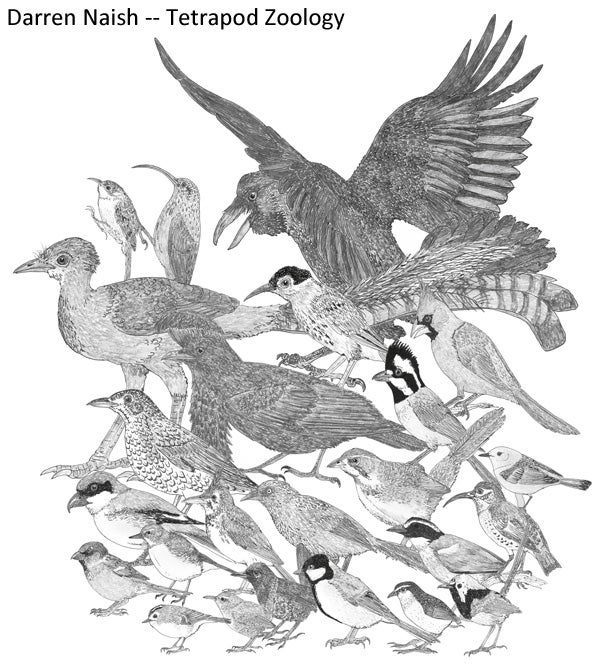
In-prep passerine montage. More groups are being added right now [click here for more]. Credit: DARREN NAISH
Once upon a time, views on passerine phylogeny were quite vague: while there had long been efforts to group the numerous family-level groups into clades, the way in which they were thought arranged changed significantly from one author to the next. From the 1870s onwards it became generally agreed that passerines consisted of the songbirds or oscines (also called Passeri), and the suboscines (also called Clamatores or Tyranni). During the early 1900s, broadbills and lyrebirds were awarded their own higher groups (Eurylaimi and Menurae) alongside these two.
On supporting science journalism
If you're enjoying this article, consider supporting our award-winning journalism by subscribing. By purchasing a subscription you are helping to ensure the future of impactful stories about the discoveries and ideas shaping our world today.
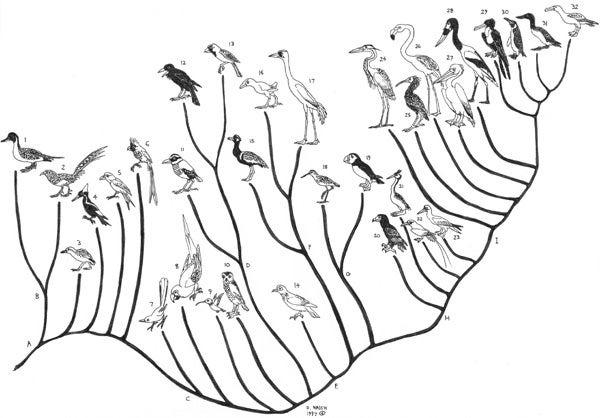
Here's that representation of the Sibley & Ahlquist (1990) tapestry that you might have seen here before. Note that passerines (the branch that includes a pitta, a crow and a sparrow) are in a somewhat unexpected position in this particular tree: they're somewhere 'in the middle' rather than shown as one of the younger branches at far right. Credit: DARREN NAISH
Skip forwards a few decades and Sibley & Ahlquist (1990) argued on the basis of DNA data that oscines belong either to a crow lineage (Corvida) or a sparrow lineage (Passerida), that broadbills are part of Tyranni, and that lyrebirds are part of Corvida within Passeri. The monophyly of Corvida then broke down, subsequent studies showing that lyrebirds, scrubbirds, bowerbirds, Australian treecreepers, pardalotes, fairywrens, honeyeaters and others are outside the clade that includes crows and kin (‘core corvoids’) and Passerida. What has happened since then? Here are a few general thoughts on passerine phylogeny as a whole – I’ll expand on various of the specifics in later articles. Let’s keep it brief…
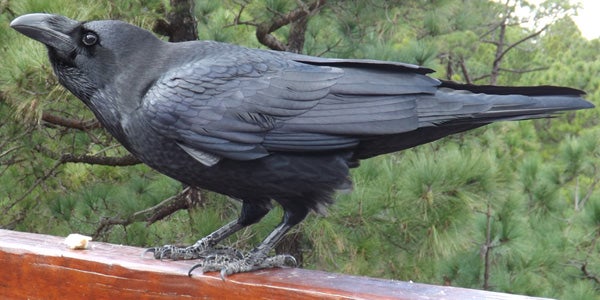
It is an empirical fact that Northern ravens Corvus corax are awesome. I photographed this bird on La Palma, Canary Islands. Credit: DARREN NAISH
Studies have repeatedly confirmed the existence of a sister-group relationship between New Zealand wrens (Acanthisittidae) and Eupasseres, the clade containing remaining crown-passerines. This fact – combined with the mostly South American, African and Australasian distribution of suboscines and the groups formerly included within Corvida – indicate Gondwanan origins for passerines as a whole. Within recent years the role of Africa in this story has become more important, especially within the context of early evolution within Passerida.
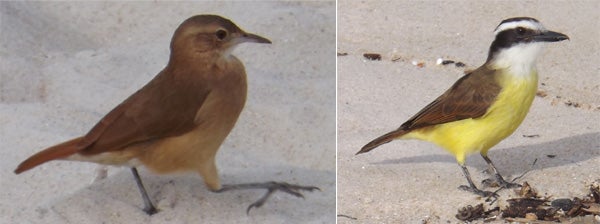
New World suboscines encountered in Brazil. At left, Rufous hornero or Red ovenbird Furnarius rufus. At right, Great kiskadee Pitangus sulphuratus. Credit: DARREN NAISH
Suboscines appear to consist of distinct Old World and New World clades, though the presence of the Sapayoa Sapayoa aenigma of northern South America within the Old World clade is an intriguing anomaly. New World suboscines are a fascinating, diverse and enormous bunch that I’ve only ever written about fleetingly (see links below): this is where we find tyrant flycatchers, cotingas, manakins, ovenbirds, woodcreepers, antbirds and so on. There are birds here that convergently resemble woodpeckers, creepers, thrushes, larks, dippers and warblers.
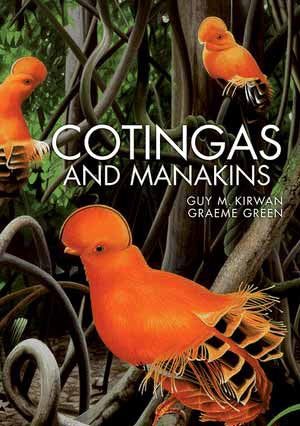
A must-have volume for those seriously interested in South American passerines. My thoughts on the book here. Credit: Princeton University Press
A bird described as one of the weirdest of them all – the chick of the Elegant mourner Laniisoma elegans – also belongs here. It’s covered in long, spike-like filaments. The somewhat similar chick of the Cinereous mourner Laniocera hypopyrra has recently been identified as the Batesian mimic of long-haired, poisonous caterpillars (Londoño et al. 2015). Tyrant flycatchers, manakins, cotingas and their kin consist of about 400 species. We now recognise that many species previously spread across these groups should be united within Tityridae (Ohlson et al. 2008), the tityres.
Moving now to Passerida, the general phylogenetic pattern as goes the larger groups within this clade now looks fairly stable. Lineages mostly group within a modified version of Sylvioidea (swallows, bulbuls, babblers, warblers, larks), Passeroidea (pipits, wagtails, icterids, wood-warblers, tanagers, cardinals, finches, weavers, sparrows), Certhioidea (treecreepers, nuthatches, wrens) and Muscicapoidea (Old World flycatchers, thrushes, dippers, waxwings, starlings, mockingbirds) (Cracraft et al. 2004, Johansson et al. 2008, Wu et al. 2015). Several different hypotheses have been proposed on the branching order of these main groups.
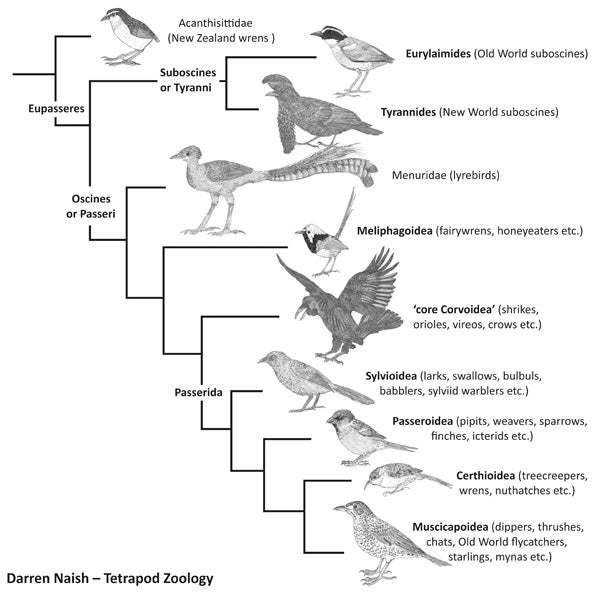
Simplified passerine phylogeny showing only major lineages, the more important group names shown in bold. Credit: DARREN NAISH
A number of additional groups are generally found to be outside any of these groups and move around from one study to the next, including rockjumpers and rockfowl, tits (Paridae), Hyliota, kinglets (Regulidae), Australian robins (Petroicidae) and fairy flycatchers (Stenostiridae). Tits might be close to, or part of, Sylvioidea (Johansson et al. 2008, Wu et al. 2015) and kinglets might belong within Sylvioidea (Sturmbauer et al. 1998) or Passeroidea (Alström et al. 2013) or Muscicapoidea (Wu et al. 2015)… though I was holding out hope that they might prove to belong to Corvoidea (Spicer & Dunipace 2004).
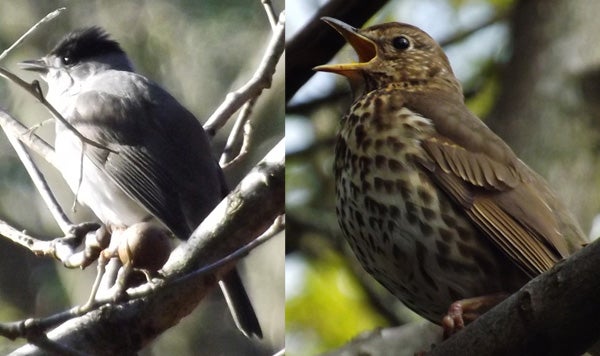
Passerines I have known. Both species here belong to the passeridan clade Muscicapoidea. At left, a singing male Blackcap Sylvia atricapilla. At right, singing male Song thrush Turdus philomelos (with damaged foot). Credit: DARREN NAISH
Several conventional ‘family-level’ groups within these lineages have been suggested to be non-monophyletic in recent studies, among them Locustellidae, Sylviidae, Cisticolidae and Cettiidae. Indeed, it’s worth saying at this point that modern molecular studies of passerine phylogeny have basically shown non-monophyly for traditional groups (those conventionally regarded as subfamilies, tribes, genera and subgenera) to be the norm, for paraphyly to be everywhere. Here’s one relevant statement from just one study, in this case pertaining to the Cettia warblers: “The remarkably high degree of non-monophyly in the genus Cettia is likely to be one of the most extraordinary examples of misconceived relationships in an avian genus” (Alström et al. 2011). If you can think of a familiar, polyspecific passerine genus, it’s probably paraphyletic or even polyphyletic. Is this a problem affecting passerine genera in particular, or is it a universal trait of the entities we term genera?
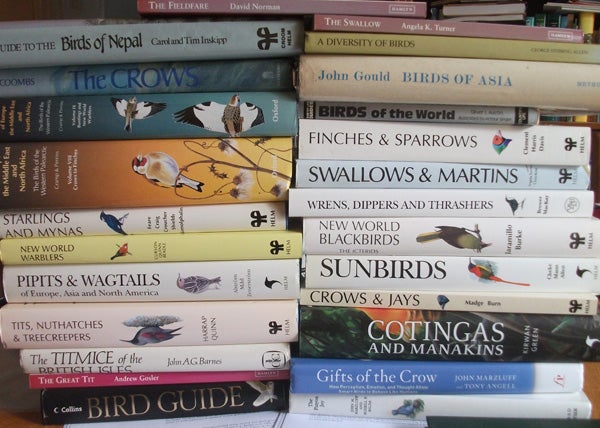
Books on passerines. This photo was taken in 2014, and I've acquired a few additional passerine-themed books since then. Credit: DARREN NAISH
At the same time, the discovery that various taxa previously lumped into big, poorly resolved or unresolved groups seemingly represent distinct lineages has led to a proliferation of new ‘families’. Even if you’re a long-time fan of the literature on avian taxonomy and phylogeny, how familiar are you with Melanocharitidae, Eupetidae, Macrosphenidae, Pnoepygidae, Donacobiidae, Bernieridae, Erythrocercidae, Scotocercidae, Pellorneidae, Elachuridae, Arcanatoridae or Urocynchramidae? These groups have mostly been named since 2006, though some are older. I find this profusion of new names – many of which pertain to lineages that contain a single extant taxon – somewhat ironic given that we’re living in an age when it’s otherwise thought that higher taxonomic categories for named lineages are redundant (example: Urocynchramidae contains the sole taxon Urocynchramus pylzowi, meaning that the names Urocynchramidae, Urocynchramus and Urocynchramus pylzowi all have identical content). Furthermore, at least some of these proposed groups are hastily named on the basis of a single study and it’s sometimes too early to tell whether they’ll survive the rigours of later scrutiny.
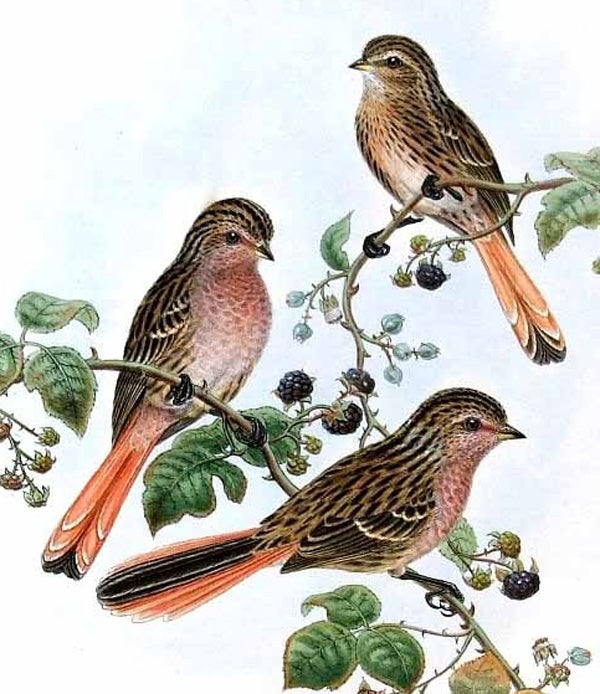
Przewalski's finch Urocynchramus pylzowi, one of several living passerines recently deemed distinct enough to warrant recognition of a unique 'family'. Credit: John Gould Wikimedia
In future articles I aim to discuss recent findings within the various passerine groups in somewhat greater depth; workload prevents me from doing more… On that note, those of you who support me on patreon (thank you!) will have seen the illustrations featured here come together over recent days, and a great many more are due to appear yet. Tetrapod Zoology needs to change, and I need assistance at patreon for this to happen.
For previous Tet Zoo articles on passerines, see…
Eurylaimides, Tyrannida and Furnariida: the suboscine passerines
Great tits: still murderous, rapacious, flesh-rending predators!
My local magpie family: four weeks of observation, 265 photos, and how good are the results
Chiffchaffs: a view of passerines from the peripheries (part I)
More passerines as seen from the peripheries (part III): Great tits!
Refs - -
Alström, P., Höhna, S., Gelang, M., Ericson, P. G. P. & Olsson, U. 2011. Non-monophyly and intricate morphological evolution within the avian family Cettiidae revealed by multilocus analysis of a taxonomically densely sampled dataset. BMC Evolutionary Biology 11: 352.
Alström, P., Olsson, U. & Lei, F. 2013. A review of the recent advances in the systematics of the avian superfamily Sylvioidea. Chinese Birds 4, 99-131.
Cracraft, J., Barker, F. K., Braun, M., Harshman, J., Dyke, G. J., Feinstein, J., Stanley, S., Cibois, A., Schikler, P., Beresford, P., García-Moreno, J., Sorenson, M. D., Yuri, T. & Mindell, D. P. 2004. Phylogenetic relationships among modern birds (Neornithes): towards an avian tree of life. In Cracraft, J. and Donoghue, M. (eds), Assembling the Tree of Life. Oxford University Press (Oxford), pp. 468-489.
Johansson, U. S., Fjeldså, J. & Bowie, R. C. K. 2008. Phylogenetic relationships within Passerida (Aves: Passeriformes): a review and a new molecular phylogeny based on three nuclear intron markers. Molecular Phylogenetics and Evolution 48, 858-876.
Londoño, G. A., García, D. A. & Sánchez Martínez, M. A. 2015. Morphological and behavioral evidence of Batesian mimicry in nestlings of a lowland Amazonian bird. The American Naturalist 185, 135-141.
Ohlson, J., Fjeldså, J. & Ericson, P. G. P. 2008. Tyrant flycatchers coming out in the open: phylogeny and ecological radiation of Tyrannidae (Aves, Passeriformes). Zoologica Scripta 37, 315-335.
Sibley, C. G. & Ahlquist, J. E. 1990. Phylogeny and Classification of Birds. Yale University Press, New Haven, Connecticut.
Spicer, G. S. & Dunipace, L. 2004. Molecular phylogeny of songbirds (Passeriformes) inferred from mitochondrial 16S ribosomal RNA gene sequences. Molecular Phylogenetics & Evolution 30, 325-335.
Sturmbauer, C., Berger, B., Dallinger, R. & Foger, M. 1998. Mitochondrial phylogeny of the genus Regulus and implications on the evolution of breeding behavior in sylvioid songbirds. Molecular Phylogenetics & Evolution 10, 144-149.
Lina Wu, Yanfeng Sun, Juyong Li, Yaqing Li, Yuefeng Wu & Dongming Li 2014. A phylogeny of the Passerida (Aves: Passeriformes) based on mitochondrial 12S ribosomal RNA gene. Avian Research 2015 6:1 doi: 10.1186/s40657-015-0010-5